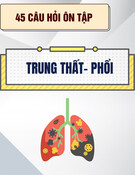
HUE JOURNAL OF MEDICINE AND PHARMACY ISSN 1859-3836 79
Hue Journal of Medicine and Pharmacy, Volume 13, No.6-2023
Microscopic characteristics, chemical compositions and bioactivities of
Alpinia vietnamica
Nguyen Dinh Quynh Phu1*, Nguyen Hoai Bao Chau1, Doan Quoc Tuan1,
Nguyen Khanh Thuy Linh1, Tran Van Nguyen2, Le Thi Khanh Linh2
(1) University of Medicine and Pharmacy, Hue University
(2) Family Hospital, Danang
Abstract
Background: The genus Alpinia is one of the diverse genera in Thua Thien Hue province, in which many
species have been used as medicine. But until now, studies on A. vietnamica have rarely been reported.
Objectives: The present study was aimed at the determination of microscopic characteristics and chemical
compositions as well as evaluating the antioxidant and acetylcholinesterase inhibitory activities of A.
vietnamica. Materials and methods: A. vietnamica was collected in Phong Dien district, Thua Thien Hue
province. Anatomic structures and powder properties were determined by the microscopic method.
Phytochemical screening was conducted by specific chemical reactions. The Folin-Ciocalteau method and the
aluminum chloride-flavonoid assay, respectively, were used to quantify the total polyphenol (TPC) and total
flavonoid contents (TFC). Antioxidant activity was assessed using the DPPH assay, while acetylcholinesterase
(AChE) inhibitory activity was evaluated using the Ellman method. Results: The microscopic characteristics
of this species have been described. Phytochemical analysis results revealed the presence of flavonoids,
coumarins, and tannins in A. vietnamica. The ethanol extract from the aerial part of A. vietnamica had higher
polyphenol and flavonoid contents than the underground part extract. Moreover, this extract also displayed
a stronger DPPH radical scavenging and exhibited AChE inhibitory activities. Conclusion: This is the first
report on the microscopic characteristics, chemical compositions, and biological activities of A. vietnamica.
Keywords: Alpinia vietnamica, microscopic characteristics, chemical constituents, antioxidant activity,
acetylcholinesterase inhibitory
Corresponding author: Nguyen Dinh Quynh Phu. Email: ndqphu@huemed-univ.edu.vn
Recieved: 15/9/2023; Accepted: 12/12/2023; Published: 31/12/2023
DOI: 10.34071/jmp.2023.6.10
1. BACKGROUND
Alpinia is a large genus of the Ginger family
(Zingiberaceae) with over 250 species that are
widely distributed in Asia. In many countries around
the world, species in this genus have been used
for traditional medicine, food, and spices. Fruits,
seeds, leaves, and rhizomes of these medicinal
plants are frequently used to treat digestive
system diseases such as indigestion, stomach
pain, and vomiting, or as anti-inflammatory drugs.
Terpenoids, diarylheptanoids, lignans, flavonoids,
alkaloids, essential oils, and other compounds are
found in Alpinia genus. Extracts and compounds
isolated from this genus have a variety of beneficial
biological properties, such as the ability to inhibit the
growth of cancer cells, antioxidant, antimicrobial,
cardioprotective activities, and reduce blood sugar
levels, etc [1].
There are approximately 31 species of Alpinia
grown or living under the canopy of forests,
streams, and wet places in Vietnam. Many species
have been used as medicine, spices, and considered
raw materials for essential oil extraction. Studies
on the genus Alpinia in Vietnam mainly focus on
analyzing the essential oil composition of some
species, such as A. oblongifolia, A. malaccaensis,
A. menghaiensis, A. pinnanensis, A. polyantha, A.
strobiliformis and A. tonkinensis [2]. Alpinia is well
known as a biodiversity genus in Thua Thien Hue
province, with many valuable medicinal species,
including A. vietnamica [3]. It was discovered in
Central Vietnam and is a newly identified species
in 2019 [4]. As far as we know, there has not been
any study about the microscopic characteristics,
chemical compositions, and bioactivities of A.
vietnamica. Therefore, the objective of this study
is to determine the microscopic characteristics,
preliminary phytochemical screening, and evaluate
the total polyphenol and total flavonoid contents as
well as the antioxidant and anti-acetylcholinesterase
activities of A. vietnamica.
2. MATERIALS AND METHODS
2.1. Materials
The whole of Alpinia vietnamica H.D. Tran,
Luu & Škorničk. (Zingiberaceae) was collected in






























